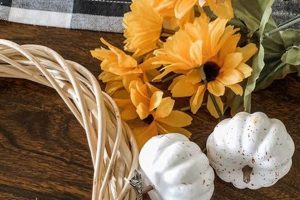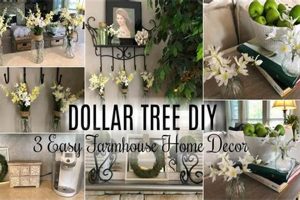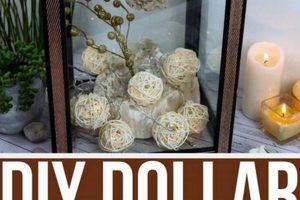The concept involves constructing a tiered serving platform, typically for displaying baked goods, utilizing affordable materials sourced from a discount retailer. The components often include plates, candle holders, and adhesive, combined creatively to form a functional and aesthetically pleasing display. For instance, attaching a glass plate to the top of an inverted glass candlestick creates a simple, single-tiered version.
This practice gains popularity due to its cost-effectiveness and potential for customization. It presents an accessible avenue for individuals to create unique dcor items for events or personal use, mitigating the expense associated with commercially produced alternatives. The availability of diverse materials at low prices fosters experimentation and personalized designs, enhancing the appeal of do-it-yourself crafting.
The subsequent sections will delve into specific techniques for assembling these stands, exploring different design possibilities, and outlining safety considerations for construction and usage.
Construction and Design Considerations
The following recommendations aim to improve the stability, aesthetics, and overall success of constructed serving platforms.
Tip 1: Material Selection: Prioritize glass or ceramic components for durability and ease of cleaning. Opt for plates with a substantial rim to prevent items from sliding off. Evaluate the weight-bearing capacity of each element to ensure it can support the intended load.
Tip 2: Adhesive Choice: Employ a strong, clear-drying adhesive suitable for bonding glass to glass or glass to ceramic. Epoxy resins generally provide a robust bond and water resistance, although proper ventilation is crucial during application.
Tip 3: Structural Integrity: Before permanent adhesion, dry-fit all components to confirm alignment and stability. Consider adding a weighted base to the lowest tier to enhance stability and prevent tipping.
Tip 4: Surface Preparation: Thoroughly clean and degrease all surfaces prior to applying adhesive. Residue or contaminants can compromise the bond strength and lead to structural failure.
Tip 5: Tiered Arrangement: Vary plate sizes to create visual interest and maximize surface area. Smaller plates atop taller bases create a dynamic, eye-catching presentation. Consider the overall height; excessive height can diminish stability.
Tip 6: Safety First: When working with glass or adhesives, ensure proper ventilation and wear appropriate safety glasses and gloves. Avoid using excessive force during assembly, as glass components are fragile.
Tip 7: Decorative Enhancements: After assembly, consider adding decorative elements such as paint, ribbon, or adhesive gems to personalize the serving platform. Ensure that any added embellishments do not compromise food safety or structural integrity.
Adhering to these suggestions can increase the likelihood of producing a sturdy and visually appealing serving platform. Careful planning and execution are vital for achieving optimal results.
The following section explores different design variations and creative applications.
1. Affordability
Affordability is a cornerstone of crafting tiered serving platforms using materials from discount retailers. The motivation to construct such items often stems from the desire to obtain a visually appealing display piece at a fraction of the cost compared to purchasing commercially manufactured versions. This cost-conscious approach allows individuals to allocate resources to other event-related expenses or personal needs.
The utilization of low-cost materials directly translates to savings. For instance, a glass plate and a candlestick, each costing one dollar, can be combined to create a basic stand for a total material cost of two dollars. A comparable commercially produced item might retail for ten dollars or more. The difference represents a significant cost reduction, particularly when multiple stands are required for large events.
The appeal rests in its accessibility. The low material costs democratize the process, enabling a broader range of individuals to participate in creating decorative elements for various occasions. This contrasts with the exclusivity potentially associated with higher-priced alternatives. Despite the low cost, attractive and functional stands can be achieved with creativity and proper execution. The cost-effectiveness facilitates experimentation, increasing the likelihood of developing customized and unique designs. Affordability is a central driver, influencing material selection, design complexity, and the overall accessibility of this DIY activity.
2. Customization
Customization constitutes a core advantage within the context of constructing tiered serving platforms from materials available at discount retailers. The opportunity to tailor the appearance, size, and style of the stand significantly enhances its appeal and utility.
- Material Variation
Discount retailers offer a range of plates, bowls, and decorative items that can be incorporated. The selection of specific colors, patterns, and materials facilitates the creation of a stand that complements a particular event theme or personal aesthetic. This contrasts with the limited selection available in pre-made, commercially available options.
- Height and Tier Configuration
The ability to adjust the height and number of tiers allows for a structure that appropriately accommodates specific items or display needs. For instance, a taller stand may be preferred for displaying cupcakes, while a lower, multi-tiered option is suitable for showcasing smaller pastries or appetizers. This degree of control is not typically found in standard serving stands.
- Decorative Embellishments
Plain serving platforms can be transformed through the application of paint, ribbon, adhesive gems, or other decorative elements. The addition of personalized embellishments allows the creation of a one-of-a-kind display piece that reflects individual creativity or event-specific branding. This level of personalization is difficult to achieve with mass-produced items.
- Functional Adaptations
Beyond aesthetics, customization can extend to functional aspects. Incorporating features such as rotating bases or tiered platforms with varying diameters can enhance accessibility and visual appeal. Modifying the structure to accommodate specific items, such as floral arrangements or lighting elements, further increases its utility.
The various forms of customization offer a significant advantage when creating serving platforms using discount retail materials. The flexibility to tailor the design to precise needs ensures that the finished product meets both aesthetic and functional requirements, often exceeding the capabilities of commercially available alternatives. Customization enhances the value proposition of a do-it-yourself solution, making it a compelling alternative for individuals seeking unique and cost-effective display options.
3. Functionality
The concept of a tiered serving platform crafted from materials sourced from discount retailers, while often emphasizing affordability and aesthetics, must also address functional requirements. The utility of such a stand hinges on its capacity to reliably support and effectively display its intended contents.
- Load-Bearing Capacity
The primary functional consideration is the stand’s ability to bear the weight of the items it is intended to display. The selected materials, adhesive, and structural design must ensure adequate support to prevent collapse or instability. For example, heavier cakes necessitate a more robust base and sturdier adhesive than lighter pastries. Failure to account for load can result in product damage or potential hazards.
- Surface Area and Accessibility
The dimensions of the tiers and their arrangement directly impact the usable surface area and accessibility of the displayed items. Sufficient space is needed to accommodate the quantity and size of the items. The arrangement of tiers should allow for easy access to all items without obstruction. For instance, densely packed tiers can hinder visibility and ease of access, diminishing the overall utility of the stand.
- Stability and Balance
A stable and balanced design is crucial to prevent tipping or accidental displacement of the stand and its contents. The center of gravity and base area must be carefully considered to ensure stability, especially when placing heavier items on upper tiers. A wide base and strategically placed weights can enhance stability, while a poorly balanced design can create a significant risk of spillage or damage.
- Cleanability and Hygiene
The materials and construction methods should facilitate easy cleaning and maintenance to ensure hygienic food display. Non-porous materials are preferable to prevent absorption of liquids or food particles. The design should allow for easy access to all surfaces for cleaning. Intricate designs with hard-to-reach areas can compromise hygiene and limit the functional lifespan of the stand.
These functional considerations, in conjunction with aesthetic goals, determine the overall success of a do-it-yourself serving platform created from discount retail materials. A visually appealing stand that lacks structural integrity or compromises hygiene offers limited practical value. Thorough consideration of these functional factors is essential for creating a useful and reliable display piece.
4. Stability
Stability is a paramount concern in the creation of tiered serving platforms using materials from discount retailers. The inherent nature of these do-it-yourself projects necessitates a rigorous focus on structural integrity to ensure the safe and effective display of food items. A lack of stability can lead to product damage, personal injury, and overall failure of the intended purpose.
- Base Weight and Distribution
The weight of the base, and its distribution, is crucial for overall stability. A heavier base provides a lower center of gravity, reducing the risk of tipping. For instance, using a thicker or weighted plate as the base significantly improves stability. Inadequate base weight, especially when upper tiers are loaded, drastically increases the likelihood of instability, rendering the stand unusable and potentially hazardous.
- Adhesive Strength and Surface Contact
The adhesive bonding the components must possess sufficient strength to withstand the weight and potential shifting of items on the stand. Furthermore, the surface area of the bonded joints significantly impacts the overall strength. An insufficient bond, whether due to weak adhesive or limited surface contact, creates a point of failure. For example, using a small amount of glue to attach a heavy glass plate to a candlestick can result in separation under load, leading to collapse.
- Tier Height and Width Ratios
The ratio between the height of the tiers and their width affects stability. Taller, narrower tiers are inherently less stable than shorter, wider ones. Exceeding a critical height-to-width ratio significantly increases the risk of toppling. Strategic use of wider plates on lower tiers and shorter bases between tiers mitigates this risk. Conversely, a tall, narrow design is prone to instability, even with a weighted base.
- Load Placement and Center of Gravity
The placement of items on the tiers directly influences the center of gravity of the assembled stand. Uneven weight distribution can shift the center of gravity, increasing the likelihood of tipping. Placing heavier items on the lower tiers and lighter items on the upper tiers lowers the center of gravity and enhances stability. Failure to consider load placement can create a precarious imbalance, rendering the stand unusable and potentially dangerous.
These inter-related considerations underscore the critical importance of stability in the design and construction of tiered serving platforms using discount retail materials. Neglecting these aspects compromises functionality and safety, negating the potential cost savings and aesthetic benefits.
5. Aesthetics
Aesthetics constitute a pivotal component in the crafting of tiered serving platforms from materials sourced at discount retailers. While cost-effectiveness and functionality are primary considerations, the visual appeal significantly enhances the perceived value and suitability of the finished product for various occasions.
- Color Coordination and Harmony
The selection of complementary colors in plates, bases, and embellishments influences the overall visual impact. Harmonious color schemes create a cohesive and pleasing appearance, while clashing colors can detract from the presentation. For example, a pastel-themed event may benefit from soft, muted tones, while a vibrant celebration might call for bolder, more contrasting hues. Careful color selection elevates the perceived quality of the assembled piece.
- Texture and Material Contrast
Juxtaposing different textures and materials adds visual interest and depth. Combining smooth glass plates with textured ceramic bases, or incorporating elements like lace or ribbon, creates a tactile and visually stimulating effect. The contrast between matte and glossy surfaces, or between rough and smooth textures, enhances the aesthetic complexity of the stand. Overuse of similar textures, however, can result in a visually monotonous display.
- Form and Proportion
The overall shape and proportions of the tiered serving platform contribute significantly to its aesthetic appeal. A balanced and visually pleasing design requires careful consideration of the height, width, and spacing of the tiers. A disproportionately tall or narrow stand can appear unstable or awkward. The strategic use of varying plate sizes and base heights creates a dynamic and visually engaging form. Balanced proportions convey a sense of harmony and visual stability.
- Embellishments and Decorative Elements
The addition of carefully chosen embellishments can transform a simple serving platform into a visually striking centerpiece. Elements such as paint, adhesive gems, ribbon, or floral accents can enhance the aesthetic appeal and personalize the design. However, moderation is key; excessive embellishment can overwhelm the design and detract from the presentation of the displayed items. Strategic placement and restrained application of decorative elements can elevate the aesthetic value without compromising the overall design integrity.
These aesthetic considerations, interwoven with functional and economic factors, determine the overall success of crafting tiered serving platforms from discount retail materials. Attention to detail in color selection, texture contrast, form, and embellishment transforms a basic do-it-yourself project into a visually appealing and functional display piece, suitable for a wide range of events and occasions.
6. Accessibility
Accessibility, in the context of crafting tiered serving platforms using materials from discount retailers, refers to the ease with which individuals can undertake and complete the project, irrespective of their prior skills, financial constraints, or physical limitations. It is a foundational element, influencing project feasibility and broadening participation. The readily available, inexpensive materials are cause of the democratization of craft activities.
A crucial element of accessibility is the simplicity of the construction techniques. The typical methods, such as adhesive bonding, require minimal specialized tools or advanced skills. This low entry barrier contrasts sharply with projects demanding complex joinery or specialized equipment. Example: Using readily available glue ensures an accessible project for all individuals, regardless of background crafting skills. Moreover, readily sourced instruction, via online videos and tutorials, further reduces the knowledge gap. The practical implication is a wider audience capable of participating in creative activities, fostering a sense of accomplishment and resourcefulness.
However, challenges remain. Individuals with physical limitations, such as reduced dexterity or strength, may encounter difficulties with certain steps, such as applying adhesive precisely or lifting heavier components. Addressing this requires adaptive strategies, such as pre-cut materials or assistive devices. Ultimately, the significance of accessibility lies in its potential to transform a niche craft into a widely accessible and inclusive activity, promoting creativity and resourcefulness across diverse populations.
Frequently Asked Questions
This section addresses common inquiries and concerns regarding the construction and use of tiered serving platforms created using materials sourced from discount retailers.
Question 1: What types of adhesive are suitable for bonding glass and ceramic components?
Epoxy resins and specialized glass adhesives offer a robust and durable bond. Cyanoacrylate adhesives (super glue) may provide a quick fix but are generally less resistant to stress and moisture. The selected adhesive must be compatible with the materials being bonded and capable of withstanding the anticipated load.
Question 2: How can the stability of a stand be improved, particularly with taller designs?
A wider base, achieved through the use of a larger plate or by adding a weighted element, enhances stability. Placing heavier items on the lower tiers lowers the center of gravity, further reducing the risk of tipping. Ensuring that the adhesive bond is fully cured before use is also essential.
Question 3: Are materials sourced from discount retailers food-safe?
While many plates and serving dishes from these retailers are suitable for food contact, it is advisable to verify the materials are labeled as food-safe. Avoid using items with lead-based paints or glazes for direct contact with food. Consider using cupcake liners or parchment paper as a barrier between the food and the stand’s surface.
Question 4: How can the stand be effectively cleaned after use?
Disassemble the stand carefully to prevent breakage. Wash the individual components with warm, soapy water. Avoid abrasive cleaners that could scratch the surface. Ensure all components are thoroughly dried before reassembling to prevent moisture damage to the adhesive bond.
Question 5: Can these stands be used for heavy cakes or desserts?
The load-bearing capacity of stands constructed from discount retail materials is inherently limited. For heavier items, reinforce the structure by using thicker plates and bases, and a more robust adhesive. Conduct a test load before use to ensure the stand can safely support the intended weight.
Question 6: How can the stand be personalized to match a specific event theme?
Paint, ribbon, adhesive gems, and other decorative elements can be added to customize the stand. Choose colors and materials that complement the event’s theme. Consider using stencils or templates to create intricate designs. However, avoid using embellishments that could compromise food safety or stability.
Careful attention to material selection, construction techniques, and usage guidelines will ensure the creation of a safe, functional, and aesthetically pleasing serving platform.
The following section offers concluding thoughts regarding the construction and use of these serving platforms.
Conclusion
The preceding discourse detailed aspects involved in the creation of tiered serving platforms utilizing accessible and affordable materials. Considerations of cost, structural integrity, aesthetic design, and user accessibility remain paramount throughout the construction process. The information presented intends to provide a foundational understanding of the technical and practical elements essential for achieving a successful outcome.
The effective application of the information offered represents an opportunity to derive functional, personalized serving platforms. Prudent planning and meticulous execution are critical for safety and satisfying results. The pursuit of craftsmanship through readily available resources has both practical and creative value.







